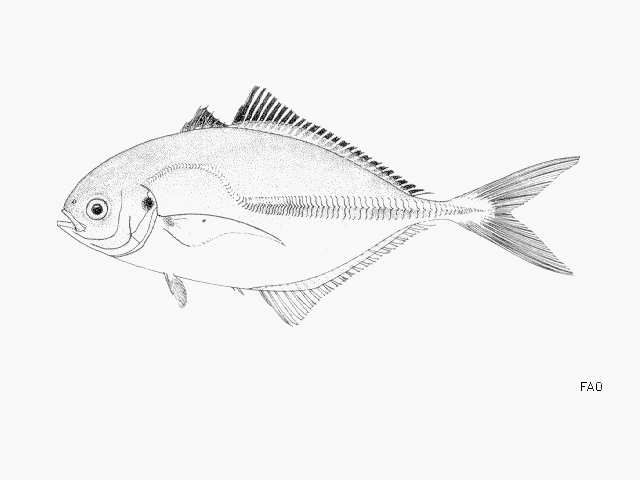| Carangidae (Jacks and pompanos), subfamily: Caranginae |
| 70 cm TL (male/unsexed) |
|
demersal; brackish; marine |
| Eastern Atlantic: Along the west African coast from Sierra Leone to Angola (Ref. 57392). Reported from the Sine-Saloum Estuary in Senegal, the Gambia River in Gambia, the Fatala River in Guinea (Ref. 28587) and from Mauritania (Ref. 55783), but this is unconfirmed in Ref. 57392 and needs confirmation. |
|
Dorsal spines (total): 8-8; Dorsal soft rays (total): 24-28; Anal spines: 3-3; Anal soft rays: 21-24. Diagnosis: body elongate (depth comprised 2.4-3.1 times in fork length) and strongly compressed; eyes small; snout short and rounded; mouth small; end of upper jaw extending to below anterior eye margin; teeth present in jaws, absent on vomer; 1st dorsal fin with 7 spines, 2nd dorsal with 1 spine and 24-28 soft rays; anal fin with 2 detached spines, followed by 1 spine and 21-24 soft rays; scales small and cycloid; breast completely scaleless; lateral line arched over anterior half of pectoral fins, its posterior (straight) part with 41-43 scutes; caudal peduncle very slender, without bilateral keels above and below last lateral line scutes (Ref. 57392).
Coloration: back bluish, sides silvery; black spot on upper margin of gill cover; dorsal- and upper caudal-fin lobes broadly black-edged, other fins light; juveniles with 4-5 dark crossbars on back and sides (Ref. 57392). |
| Adults are found mainly in coastal areas, entering brackish water (Ref. 2683, 57392). Common mostly in midwater and near bottom (Ref. 7079). Young live in association with medusa (jellyfish) (Ref. 57392). |
|
Least Concern (LC); Date assessed: 29 May 2014 Ref. (130435)
|
| harmless |
Source and more info: www.fishbase.org. For personal, classroom, and other internal use only. Not for publication.

